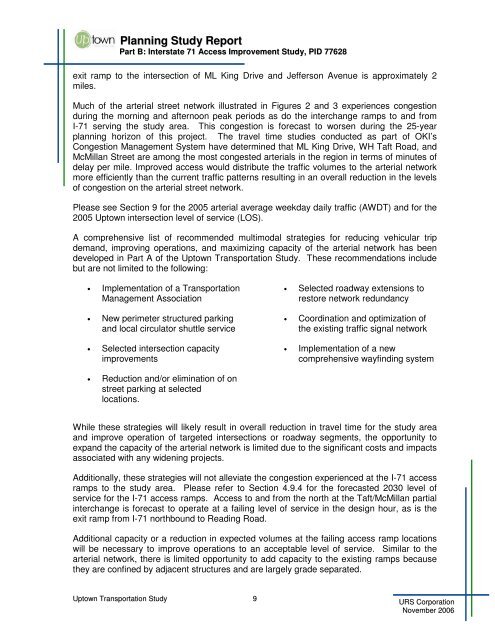Uptown Transportation Study - OKI
Uptown Transportation Study - OKI
Uptown Transportation Study - OKI
Create successful ePaper yourself
Turn your PDF publications into a flip-book with our unique Google optimized e-Paper software.
Planning <strong>Study</strong> ReportPart B: Interstate 71 Access Improvement <strong>Study</strong>, PID 77628exit ramp to the intersection of ML King Drive and Jefferson Avenue is approximately 2miles.Much of the arterial street network illustrated in Figures 2 and 3 experiences congestionduring the morning and afternoon peak periods as do the interchange ramps to and fromI-71 serving the study area. This congestion is forecast to worsen during the 25-yearplanning horizon of this project. The travel time studies conducted as part of <strong>OKI</strong>’sCongestion Management System have determined that ML King Drive, WH Taft Road, andMcMillan Street are among the most congested arterials in the region in terms of minutes ofdelay per mile. Improved access would distribute the traffic volumes to the arterial networkmore efficiently than the current traffic patterns resulting in an overall reduction in the levelsof congestion on the arterial street network.Please see Section 9 for the 2005 arterial average weekday daily traffic (AWDT) and for the2005 <strong>Uptown</strong> intersection level of service (LOS).A comprehensive list of recommended multimodal strategies for reducing vehicular tripdemand, improving operations, and maximizing capacity of the arterial network has beendeveloped in Part A of the <strong>Uptown</strong> <strong>Transportation</strong> <strong>Study</strong>. These recommendations includebut are not limited to the following:• Implementation of a <strong>Transportation</strong>Management Association• New perimeter structured parkingand local circulator shuttle service• Selected intersection capacityimprovements• Selected roadway extensions torestore network redundancy• Coordination and optimization ofthe existing traffic signal network• Implementation of a newcomprehensive wayfinding system• Reduction and/or elimination of onstreet parking at selectedlocations.While these strategies will likely result in overall reduction in travel time for the study areaand improve operation of targeted intersections or roadway segments, the opportunity toexpand the capacity of the arterial network is limited due to the significant costs and impactsassociated with any widening projects.Additionally, these strategies will not alleviate the congestion experienced at the I-71 accessramps to the study area. Please refer to Section 4.9.4 for the forecasted 2030 level ofservice for the I-71 access ramps. Access to and from the north at the Taft/McMillan partialinterchange is forecast to operate at a failing level of service in the design hour, as is theexit ramp from I-71 northbound to Reading Road.Additional capacity or a reduction in expected volumes at the failing access ramp locationswill be necessary to improve operations to an acceptable level of service. Similar to thearterial network, there is limited opportunity to add capacity to the existing ramps becausethey are confined by adjacent structures and are largely grade separated.<strong>Uptown</strong> <strong>Transportation</strong> <strong>Study</strong> 9URS CorporationNovember 2006
















